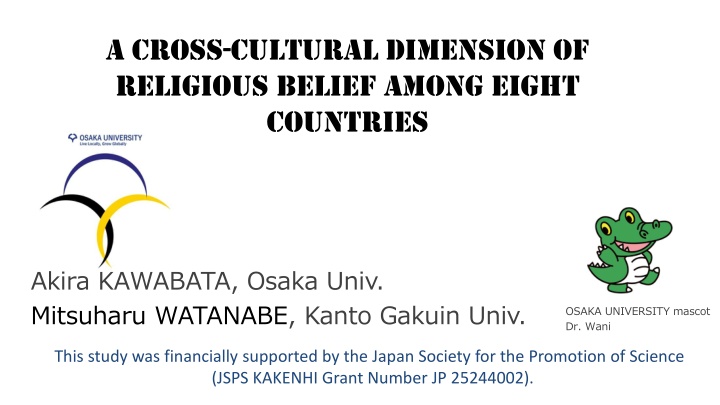
Cultural Dimensions of Religious Belief Across Eight Countries
Explore the cross-cultural dimensions of religious belief among eight countries, highlighting commonalities and differences in religious practices. The study delves into the development of questionnaires and surveys to understand the nuances of religious beliefs in various societies.
Download Presentation

Please find below an Image/Link to download the presentation.
The content on the website is provided AS IS for your information and personal use only. It may not be sold, licensed, or shared on other websites without obtaining consent from the author. If you encounter any issues during the download, it is possible that the publisher has removed the file from their server.
You are allowed to download the files provided on this website for personal or commercial use, subject to the condition that they are used lawfully. All files are the property of their respective owners.
The content on the website is provided AS IS for your information and personal use only. It may not be sold, licensed, or shared on other websites without obtaining consent from the author.
E N D
Presentation Transcript
A cross-cultural dimension of religious belief among eight countries Akira KAWABATA, Osaka Univ. Mitsuharu WATANABE, Kanto Gakuin Univ. OSAKA UNIVERSITY mascot Dr. Wani This study was financially supported by the Japan Society for the Promotion of Science (JSPS KAKENHI Grant Number JP 25244002).
Large difference?? Religion in the West and the East Japan Christian Society Korea China Islam 2
Objectives of our study To find cross-cultural commonalities in religious belief For efficient international comparative study. For understanding nation specific characters. Christian Society Islam Commonalities Japan China Korea 3
Process of questionnaire development Eliminate culturally dependent terminology Jesus, crucifix, heaven, Buddha, Nirvana Plain and general expressions Concentrate one s attention on a sacred symbol or sacred words (instead of crucifix or amen) Replace God with God(s) in order to eliminate a Christian nuance God(s) exists externally to human beings. 4
Three online religious belief surveys Year Country N of items 2010 survey The US and Japan 100 2015 survey Eight countries 186 2016 survey Eight countries 90 Eliminate/modify non-common items (examples shown later) 5
2016 survey in eight countries Country the U. S. Italy Russia Turkey Taiwan India Thailand Japan Main Religion Protestant Catholic Greek Orthodoxy Islam Taoism Hinduism Theravada Buddhism Shinto/ Mahayana Buddhism N 520 522 542 541 552 537 513 571 6
COMMON ITEMS (ONE DIMENSIONAL STRUCTURE)
One dimensional religious belief structure PCA(Principal Components Analysis) The 1stcomponent is Overwhelming Same pattern in All countries Both genders All age categories All educational levels
Easy Common items Spiritual (free from religious body) Supernatural powers and/or miracles exist. 75% 'God(s)' is a great life force that is one with the universe. 69% Combination of ethic and transcendence There is deep meaning in believing in 'God(s)' and realizing one's desires in this world.66%9
Difficult Common items Authentic religion (organization or ritual) Religious organizations are in and of themselves sacred. Super transcendental or philosophical In order to be saved by 'God(s),' one must deny himself/herself up to the present. 23% 29% 10
Remarkable common items Eastern like items Everything in this world exists in relation to each other by an invisible power. Na ve or pre-modern religiosity By believing in 'God(s),' one's income can be increased. 24% 60% 11
Significant effect on social activities High culture activities (p<0.01) Volunteer activities (p<0.01) 12
Significant effect on consciousness Experience of seeing God(s) (p<0.01) Happiness (p<0.01) Consequences of Glock and Stark s Experience of Glock and Stark s 13
Non uniform DIF as specific item Eastern like items The spirits of ancestors and/or dead family members protect their descendants when they are happy and, conversely, when suffering, influence the lives of their descendants negatively. Protestant like items Whether a certain person will be saved or not is individually preordained. 14
Conclusion One dimensional commonalities in religious belief Some nation specific items existed Commonalities affect happiness, high culture activities, and volunteer activities 15
